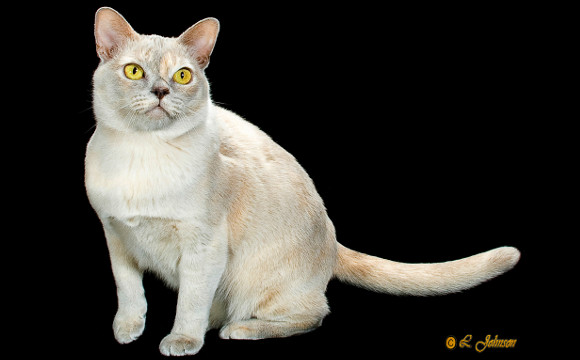The European Burmese cat breed has a rich and storied history, originating from Southeast Asia. The earliest records of a breed resembling the Burmese come from Thailand, formerly known as Siam, where they were referred to in ancient poems. These poems, dating back to the Ayutthaya period, mention cats that likely correspond to the Vichien Mat (Siamese), Si-Sawat (Korat), and Thong Daeng (Copper), the latter being the precursor to the Burmese breed.
In the late 19th century, Burmese cats were initially brought to the United Kingdom and were mistaken for chocolate-colored Siamese. This misunderstanding led to crossbreeding with Siamese cats, which nearly caused the breed to die out in Britain. It wasn’t until the early 20th century that the breed began to be recognized and developed independently. Dr. Joseph Cheesman Thompson is credited with establishing the modern Burmese breed in the United States after importing a brown female cat named Wong Mau in 1930.
Wong Mau was bred with a seal-point Siamese, Tai Mau, resulting in kittens that were foundational to the Burmese breed. Recognition from the Cat Fanciers’ Association (CFA) came in 1936, though it was later suspended due to extensive Siamese crossbreeding. By 1954, efforts to restore the breed’s purity led to the CFA lifting the suspension. The European Burmese developed separately in the United Kingdom, gaining recognition from the Governing Council of the Cat Fancy (GCCF) in 1952.
Physical Characteristics
European Burmese cats are known for their elegant and muscular build, with a medium-sized body that is both athletic and graceful. They have a distinctive head shape, featuring a short, blunt wedge and wide cheekbones. Their large, expressive eyes are a hallmark of the breed, typically golden or yellow, and their short, glossy coat comes in various colors, including blue, chocolate, cream, lilac, and red.
The breed’s coat is notably satin-like, requiring minimal grooming. The physical differences between the European and American Burmese are subtle but significant; the European variety has a more moderate and less cobby build compared to the sturdier American Burmese.
Temperament and Personality
The European Burmese is known for its playful and affectionate nature. These cats are highly intelligent and thrive on human companionship, making them unsuitable for homes where they would be left alone for long periods. They are very social and enjoy interacting with both people and other pets.
Their temperament is often compared to that of their Siamese ancestors, being energetic, curious, and talkative. However, their voices are softer and sweeter. European Burmese cats are also known for their dog-like behaviors, such as playing fetch and following their owners around the house. They are excellent with children and can adapt well to living with other cats and dogs.
Health and Care
Generally, European Burmese cats are healthy and robust, but they can be prone to certain genetic conditions. Regular veterinary check-ups are essential to ensure their health and well-being. Common health issues include:
- Hypokalemic Polymyopathy: A muscle weakness condition due to low potassium levels.
- Diabetes Mellitus: A condition that affects blood sugar regulation.
- Craniofacial Defects: Rare but severe congenital deformities.
Maintaining a balanced diet and providing regular exercise are crucial for keeping these cats healthy. Their short coat is low-maintenance, requiring only occasional brushing to remove loose hair and keep it shiny.
Living with a European Burmese
European Burmese cats are ideal for households that can provide ample attention and interaction. They are highly active and require mental stimulation through interactive toys and activities. Their inquisitive nature means they will explore every nook and cranny of your home, so cat-proofing your space is advisable.
These cats are known for their loyalty and will often follow their owners around the house. They enjoy being involved in daily activities and can be trained to perform various tricks, enhancing their bond with their human companions. Given their need for companionship, it’s beneficial to have another pet to keep them company if they are left alone for extended periods.
Breeding and Genetics
Breeding European Burmese cats requires a deep understanding of their genetic makeup to avoid potential health issues and ensure the breed’s integrity. Responsible breeders focus on maintaining genetic diversity and health. The breed’s history of crossbreeding with Siamese cats has necessitated careful selection to preserve their unique characteristics.
Conclusion
The European Burmese is a captivating breed with a rich history and a delightful personality. Their elegant appearance, coupled with their affectionate and playful nature, makes them a wonderful addition to any family. Whether you are a seasoned cat owner or new to feline companionship, the European Burmese offers a rewarding and engaging pet experience.
FAQs
Q: Are European Burmese cats good with children? A: Yes, they are excellent with children and enjoy interactive play.
Q: Do European Burmese cats require a lot of grooming? A: No, their short, glossy coat is low-maintenance and requires minimal grooming.
Q: Are European Burmese cats prone to any health issues? A: While generally healthy, they can be prone to genetic conditions like hypokalemic polymyopathy and diabetes. Regular veterinary care is essential.
Q: How active are European Burmese cats? A: They are very active and enjoy playful activities. They need mental and physical stimulation to stay happy and healthy.
Q: Do European Burmese cats get along with other pets? A: Yes, they are social and can get along well with other cats and dogs, especially if properly socialized.

